The Czech Republic is home to incredible hiking trails, but they don’t look after themselves. Well-maintained trails benefit both people and nature. They provide safe access while protecting fragile ecosystems. Keeping these paths and their associated infrastructure in good order requires work – work that often goes unnoticed by most visiting nature-lovers. The behind-the-scenes labors of local organizations, volunteers, and general enthusiasts who dedicate free time to the natural beauty in their region is what keeps these trails accessible today and will continue to do so well into the future.
Such is the work of the Ivan Dejmal Foundation for Nature Protection (Nadace Ivana Dejmala pro ochranu přírody), a nonprofit organization named after the founder of the first independent environmental organization in communist-ruled Czechoslovakia and who spent 4 years in jail as a political prisoner under the totalitarians, and of the Jizera Mountains and Ještěd Mountain Club (Jizersko-ještědský horský spolek), who restore trails in the Jizera Mountains in the north of the Czech Republic.
“Visitors belong in the mountains and forests. They should have access to them, and it’s necessary for them to see what we’re protecting and restoring. There is so much beauty out there,” asserts Ondřej Petrovský, director of the Foundation.
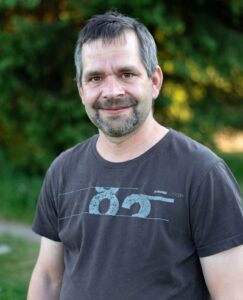
Ondřej Petrovský, director of the Ivan Dejmal Foundation for Nature Protection.
Having access to well-maintained trails isn’t something that happens automatically. There needs to be a group of enthusiastic people willing to do the work because they value the nature around them. “We maintain trails in our spare time, some of us even take time off work to do it. We enjoy it, we are out in the fresh air, doing something beneficial for nature and people,” says Michal Vinař, vice-chairman of the Mountain Club.
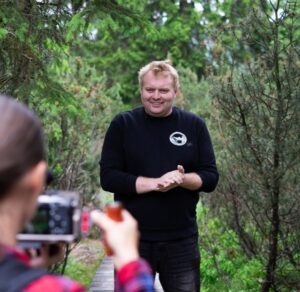
Michal Vinař, vice-chairman of the Jizera Mountains and Ještěd Mountain Club.
Together, these two organizations are contributing toward achieving the Sustainable Development Goals by protecting sensitive areas like peatlands from damage (SDG 13: Climate Action) and keeping hikers on trails to minimize habitat disturbance (SDG 15: Life on Land).
Jizera Mountains
The Jizera Mountains cover 417 km2 of forest and mountain range straddling the Czech and Polish border. An intricate web of hiking trails leads through these mountains as it does through much of the Czech Republic. “Czechs have a long-standing history of getting out into the forests and mountains,” Petrovský relates. One would be hard-pressed to find another place with such well-marked trails. As long as people stick to the path and don’t wander off, getting lost is nearly impossible. Nevertheless, these trails aren’t pure works of nature – they require continuous care. With many people frequenting the trails to unwind, exercise, or just connect with nature, the impact on the environment can add up rather quickly. If trails are to remain a safe way to experience nature, they need our help.
“If 1 or even 20 hikers pass through a forest, you can’t tell anything at all. But when dozens, even hundreds of them pass by every day, you can see the toll it has on nature.”
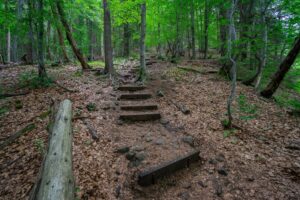
Proper steps prevent soil erosion while directing hikers along the designated path. Volunteers build this infrastructure by hand and carry in the materials on their backs.
Peatlands are an important element in the Jizera Mountains and protecting these is crucial. Maintaining trails leads people away from stepping into and disturbing peatlands. Peatlands are said to store more carbon than all other vegetation types combined, despite covering only 3% of the Earth’s land surface. They also play a vital role in preserving biodiversity, minimizing flood risk, and ensuring safe drinking water. Keeping up trails isn’t just about giving people easy access to nature but also about protecting the lands and nature around the trails.
The importance of trail maintenance
The Ivan Dejmal Foundation and Jizera Mountains and Ještěd Mountain Club have been committed for decades to conservation and restoration efforts in the Jizera Mountains. These organizations know firsthand the importance of well-maintained trails and how easily the local balance can be disrupted. “If 1 or even 20 hikers pass through a forest, you can’t tell anything at all. But when dozens, even hundreds of them pass by every day, you can see the toll it has on nature. In such numbers, it is very important that people have a designated, well-maintained trail,” says Petrovský. Without maintenance, trails deteriorate, and that leads visitors to wander off the paths and to disturb the local ecosystem.
A well-structured trail system benefits both nature and hikers. Designated trails provide people with safe access while minimizing their impacts. Keeping this balance going requires trails to be maintained – a process that involves a lot of manual labor and planning. The Foundation does the planning and the Mountain Club’s members get their hands dirty. Given that most trails are inaccessible by vehicles – and should remain that way – restoration is done entirely by hand. “Of course, it always takes extra effort to do it delicately. That’s actually the most difficult part of these projects—everything has to be done manually. All materials are carried in by hand, and everything is built on-site,” Petrovský notes.
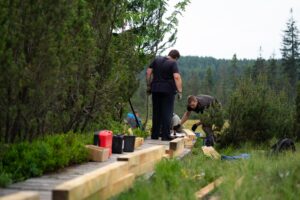
Thanks to local volunteers and generous donors, this boardwalk will enable nature-lovers to observe expansive peatlands and surrounding forest in a minimally invasive manner.
The Tři Iseriny trail, an educational path meandering through the Bukovec Nature Reserve and Jizerka Peatlands, had been in need of some updates to its aging infrastructure. Given its uphill terrain, the work included new grading, a reconstructed boardwalk, and restoration of a scenic lookout point over a peatbog. The 6-kilometer Tři Iseriny trail features 12 information points that offer deeper understanding of the area’s natural and cultural heritage. Visitors can take a look into a former basalt quarry, soak up the panorama of the western part of the Krkonoše Mountains, and learn about the history of Jizerka, the highest settlement in these mountains.
This is just one of many trails in this region. In fact, Czechs can boast of trails like these all over their country. Getting out on a trail in this part of the world is not only relaxing but also a learning experience. The educational aspects of the trails are a significant draw for both local residents and visitors. Along the trails, one comes upon informational signs and boards that provide insights into a specific region’s unique ecosystems. Signboards are very often illustrated and highlight the diverse local flora and fauna. Newer educational information stops may feature QR codes providing mobile phone access to online multimedia learning resources. Children and adults alike can learn about lesser-known animal species, the history of the landscape, and the importance of conservation efforts. Some might even end up developing an interest in birdwatching (Read about birdwatching in our previous BlueGreen Minute about a bird-watcher’s endangered paradise in Lithuania).
“Many hours of work go into each information board. We have to come up with the text, develop the graphics, have it printed, make the frame, assemble it, transport it all to the site, dig the holes, make the concrete footings. Sometimes it’s not even possible to get to the individual stops by car, so it’s quite a job to carry the information board to the top of a mountain. Sometimes we have to work hard. Sweat, tears, and occasionally even blood may all be shed before the job is finished,” quips Vinař.
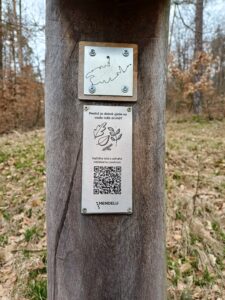
While on a trek, you might come across a state-of-the-art information board. An initiative of Mendel University in the Czech Republic involves installing QR codes on trail markers that hikers can scan. The QR code takes you to a website with information about local biodiversity. Try it here with your mobile phone!
Navigating with ease
The Czech Republic has more than 70,000 kilometers of marked trails, including hiking, cycling, skiing, and horse-riding paths. Although the country’s many trails often are interwoven, when a person finds oneself at a junction, it usually is incredibly easy to navigate due to the volunteer work of the Czech Tourist Club. The “CTC” established the Czech Hiking Markers Standard in 1888 and the system has since become an international benchmark for trail marking that is used in various countries across Central and Eastern Europe, as well as in parts of Latin America and Asia.
The system is remarkably straightforward and effective. “We certainly have the best system in Europe, maybe the entire world,” says Petrovský. Trails are marked with two short horizontal white stripes with a colored stripe in between. The colors indicate the type of trail: red for long-distance and summit trails, blue for significant trails, green for local trails, and yellow for short or connecting trails. Although paper and electronic maps exist and come in handy, hikers don’t necessarily need to use maps. Typically, they just follow the markers from one to the next.
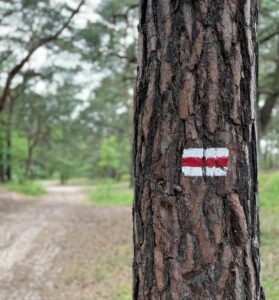
One of the many trail markings hikers follow on any given trail in the country. Just keep your eyes open for these and you cannot readily get lost.
Trail maintenance is complex
Although trail maintenance might seem straight forward, it requires a lot of documentation and planning. Preparing a single project can take years before it finally goes into the execution phase. “Even for a simple project, it’s not uncommon to spend 2 years in preparation and then implement it in just 4 months,” says Petrovský. The Czech Republic clearly values these projects and respective government ministries wholeheartedly support these efforts. Still, change does not happen overnight. Even after a project gets implemented, there is still ongoing work, because simply “building something and leaving it there is not a good solution,” Petrovský emphasizes. The restored Tři Iseriny trail is continuously monitored and updated by the Mountain Club’s more than 100 volunteers. “We try to monitor the trails mainly before and after the summer season,” Vinař relates. “We inspect individual parts of the trails for their durability and for any effects of vandalism, which, unfortunately, shows up on our trails as it does elsewhere.”
On this specific trail and project, volunteers carried out the following work:
- Built 32 completely new steps
- Repaired 123 existing steps
- Constructed 38 m2 of new walkway
- Liquidated 38.9 m2 of walkway
- Repaired 140 m2 of walkway
- Newly constructed 68 m of wooden railings
- Liquidated 57 m of existing wooden railings
- Repaired 7 m of existing wooden railings
- Repaired 8 information boards
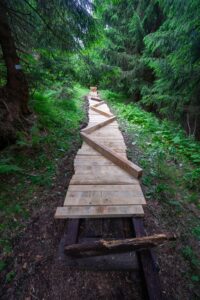
Even the best-built wooden walkway won’t last forever.
None of that would be possible without a community that is enthusiastic about its surroundings. Nearly anyone can help in some small way to keep trails in a good condition. Something over which every person has control over is one’s own footprint when visiting nature. Staying on the path, being careful not to disturb the local wildlife, and not littering are just some of the responsible behaviors important to keeping trails open, minimally disruptive, and safe.
Costs of trail maintenance
Another important aspect is the financial side of trail maintenance. This work requires substantial financial resources and even a relatively simple job can be quite costly. The Tři Iseriny trail restoration project cost 887,244 CZK (roughly 38,000 USD or 35,000 EUR) and was financed through the European Union’s Operational Programme Environment and the Ivan Dejmal Foundation, which itself relies on public contributions. The funding for such projects often comes from a mix of government grants, private donations, and corporate sponsorships. Local companies and individuals frequently contribute to these initiatives. “People have a relationship with the mountains and it shows when we try to get funding for these projects,” explains Petrovský. “I’m not saying it’s always easy, but the people and the local companies are really enthusiastic about it and willing to contribute in some way. We have big-hearted people here and you can meet them on the trails.”
Trails aren’t cities
While trail restorations upgrade accessibility and protect the environment, some might worry that all these improvements could draw in more people to the mountains and produce greater environmental damage. The Jizera Mountains, though not as overcrowded as Sněžka, the highest peak in the country, and the Krkonoše Mountains that surround it, still see very high visitor numbers, especially in certain areas. Some fear that increased infrastructure or even a UNESCO designation could draw more tourists, yet the reality suggests otherwise. The restored trails follow existing routes rather than to create new ones. That means hikers don’t wander into new areas. Not only that, but to further protect sensitive areas, the trailheads to some routes that should no longer be used are even covered over by planting new vegetation to discourage people from going there.
Moreover, nature tourism has different characteristics than does urban sightseeing. “It’s not like in a city, where everyone gathers in one place to see a monument,” Petrovský relates. “Here, nature spreads visitors out naturally.” It also tends to be the case that, instead of drawing large crowds, these trails continue to serve hikers, cross-country skiers, and cyclists who already frequent the area.
We’re just visitors
Hiking trails are more than just paths leading through nature. They connect us to the beauty of the outdoors. Maintaining these trails is a long and demanding process – one that requires dedication, resources, and a deep respect for nature. Every repaired step, rebuilt boardwalk, or reinforced railing is a testament to the collective effort of volunteers, donors, and nature enthusiasts who cherish the mountains and what mountains share with them. “We must respect that we are just visitors in nature,” Petrovský reminds. When we go to visit friends, we wouldn’t want for our hosts to be left with rubbish after our visit, and the same goes for nature. Tending to our trails rewards us with opportunity to experience beautiful scenery, escape from our everyday troubles, and inspiration to learn more about our environment. We all have a role to play in preserving the landscapes around us. It is up to us to decide whether we will contribute financially, lend a helping hand, or simply be respectful and responsible while out on our adventures.
Perhaps there is an organization near you that also cares for trails. We encourage you to tell us about it in the Comments.

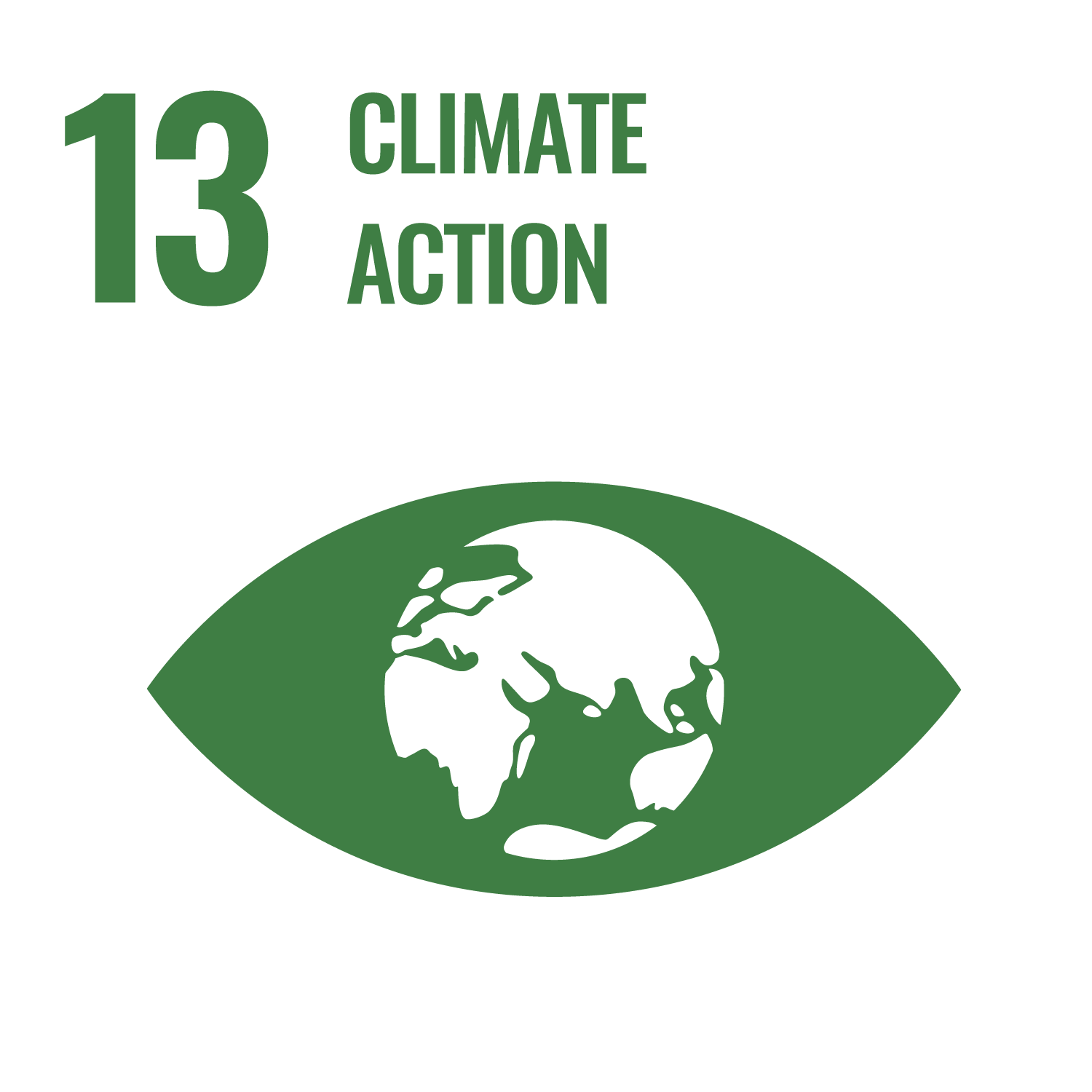
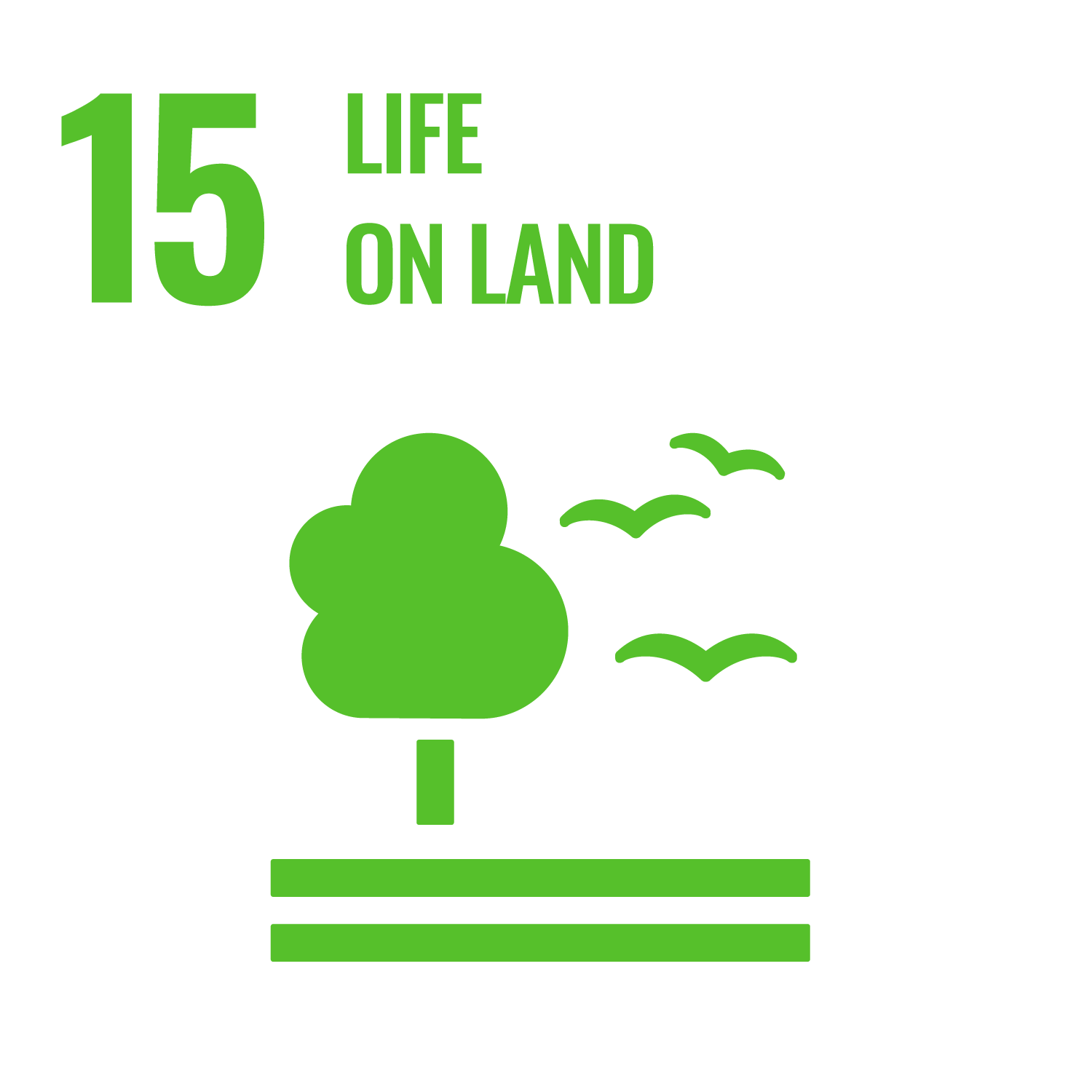
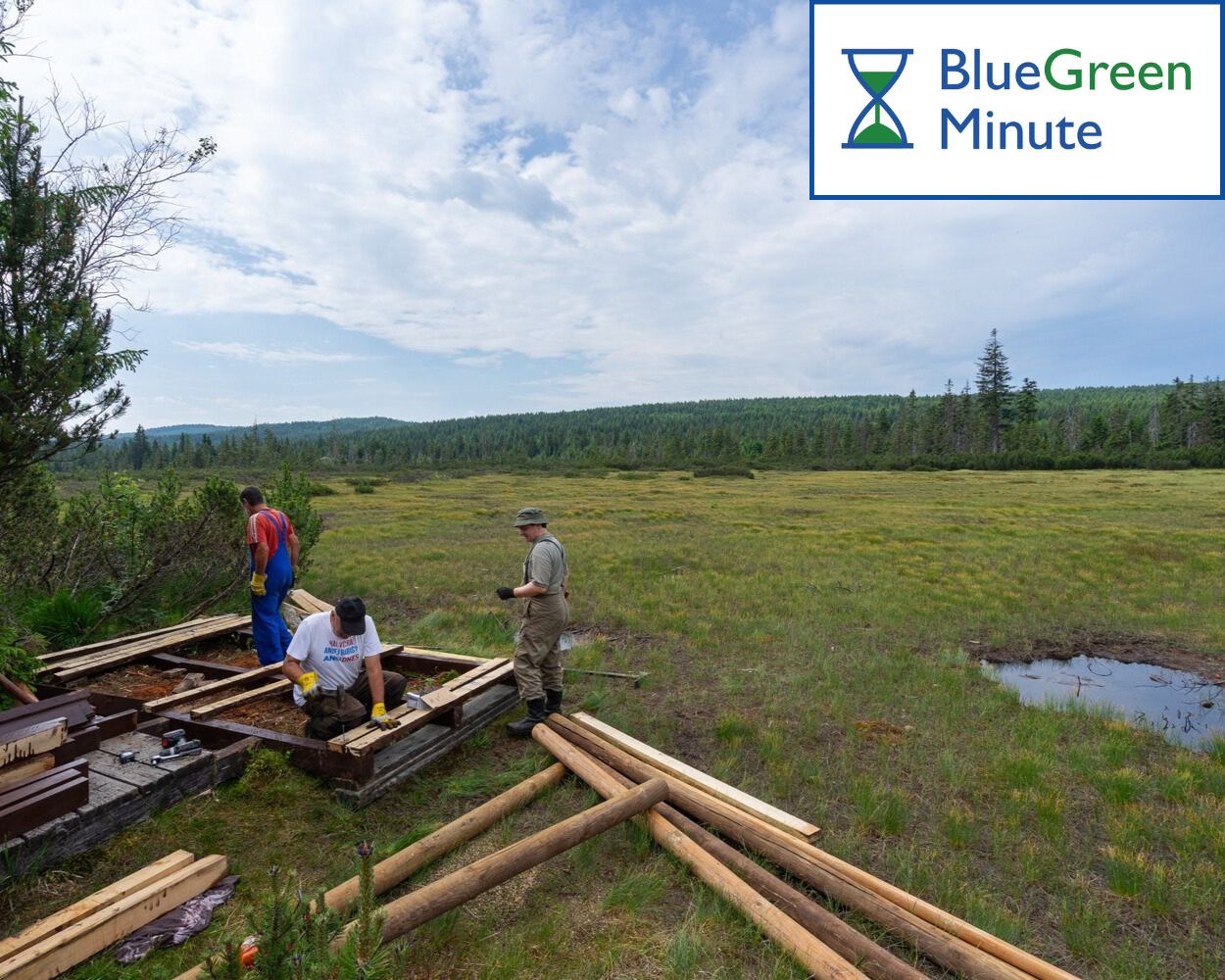
One Response
https://myteana.ru/forums/index.php?autocom=gallery&req=si&img=6607